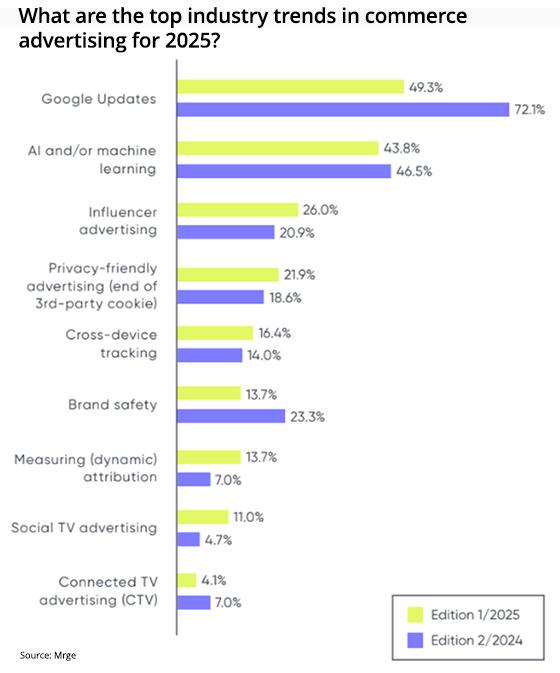
The evolution of online advertising and search has raised
important questions about trust, privacy, and continued relevance of traditional performance methods across digital. Shoppable video content and niche platforms are predicted to be the top emerging
channels for growth in the future — all tied to performance.
Advertisers have experienced some major hurdles in the past year, but according to data released Monday, the biggest obstacle
this year has been collaborating with the best partners to support consumers.
According to respondents, 41.1% say the top priority for 2025 is to try new monetization models, followed by 32.9%
who point to implementing generative AI, and 31.5% who cite expanding into new markets.
Significantly fewer respondents compared with the past survey results, have pinned hopes of growth on
expanding partnerships -- 27.4% vs. 41.9%, respectively.
advertisement
advertisement
Those partnerships today rely on a “strong movement toward a guaranteed return on investment, as well a strong flight to quality
and transparency,” said Dave Reed, CEO of Hamburg, Germany-based mrge, who spent 14 years at MediaMath in a variety of roles.
Reed said many operational efficiencies seen in programmatic
advertising four to five years ago are now coming to performance-based commerce in quality and automation.
“There’s an interesting movement today with walled gardens building
bigger walls,” he said. “When you search for something on Google, the first citation is no longer Wikipedia or a website, but their own Gemini-generated response. And they’ve done
the same on product listings, keeping you from clicking out.”
Reed said Google also has rid query results of any partnerships with content publishers who partner into commerce media.
It’s not just Google. Facebook runs a classified service, and Amazon has a large affiliate program.
Mrge defines commerce advertising as combining the strengths of performance marketing,
commerce content, and affiliate marketing. During the past year the company has invested a lot in invalid traffic detection, made investments in better leveraging data, and worked toward helping
publisher partners understand affiliate strategies.
Publishers that need to monetize content also have concerns, but theirs are around tracking, attribution and constrained internal
resources, according to a report released Monday by mrge. The study was fielded between December 5 and December 20.
Overall, nearly 30% of the 73 respondents to the study believe AI will
influence at least 20% of their website traffic, despite ongoing concerns about trust and privacy. For the average marketer there have been many tests, and Reed expects that to increase.
The
survey consisted of 53.4% of publishers, 20.5% of advertisers, and 15.1% of networks or technology providers, as well as 11% of agencies, along with other company types.
The findings also
revealed that brand safety has declined slightly as a focus area.
When survey participants were asked what type of total sales are generated by commerce advertising strategies, 48% said they
generate 20% of more of their revenue. The top tier -- which earns more than a quarter of its revenue from commerce advertising -- has seen growth rise from 23.6% to 32.9%, compared to the previous
survey wave.
The group, however, reported that less than 10% of revenue from commerce advertising has also expanded significantly, and now reaches 28.8% compared with just 11.1%
previously.
Performance-based compensation models were favored. Cost per click continued to dominate, particularly among publishers, while advertisers increasingly appreciate cost-per-lead
(CPL) approaches. Overall, CPL has seen a surge in relevance.
Changing search behavior is expected to reduce traffic, prompting varied responses across the industry. Some 46.7% of advertisers
are placing a clear emphasis on increasing budgets for search ads and social media campaigns, but they also are exploring additional channels and content on publisher sites.
The
publisher types that generated the most sales in Q4 2024 were blogs, search and product listings. They experienced consistent strong performance from influencers as top revenue drivers. In contrast,
coupon pages and loyalty programs have experienced a noticeable decline.